Toshiba T235D: AMD's 2010 Ultrathin "Nile" Platform
by Jarred Walton on August 23, 2010 11:00 PM ESTCan I Get a Good LCD? Um…No
The T235D is a $600 laptop with a mediocre LCD panel. Shocking, isn't it? We can count on one hand the number of quality LCDs we've seen in sub-$1000 laptops. (ASUS 1005HA and 1001P, please stand up!) The T235D has your typical low contrast, glossy LCD with LED backlighting to keep it reasonably bright, and that's about it.
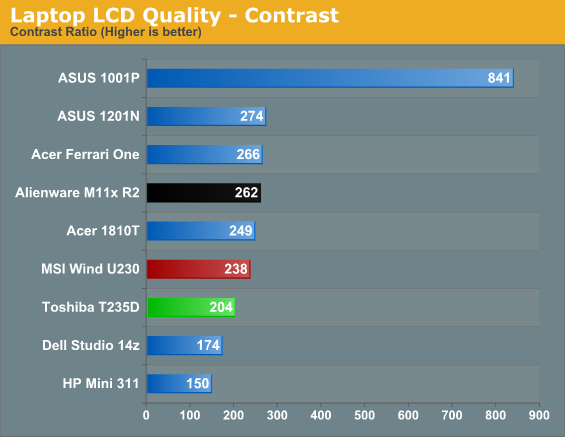
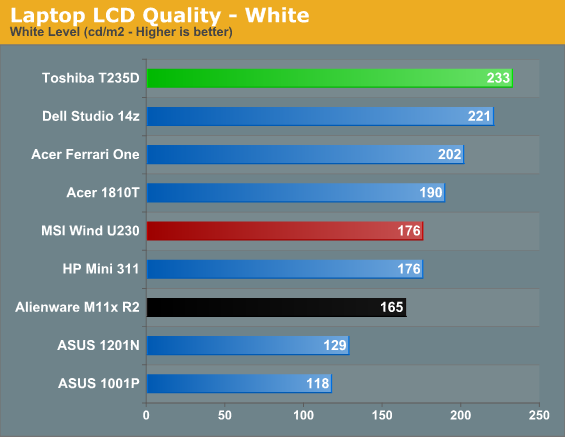
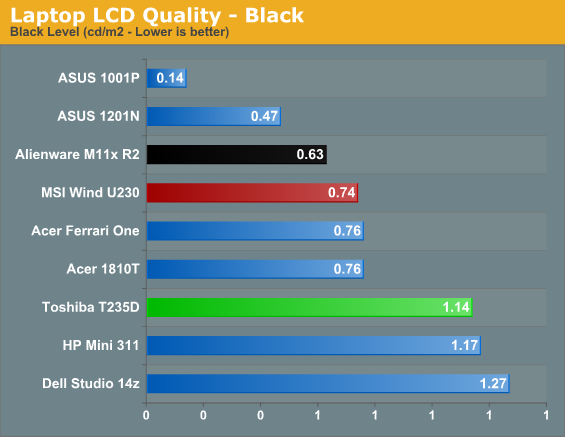
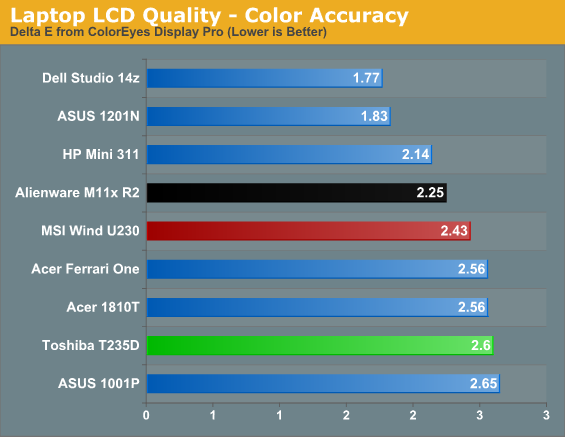
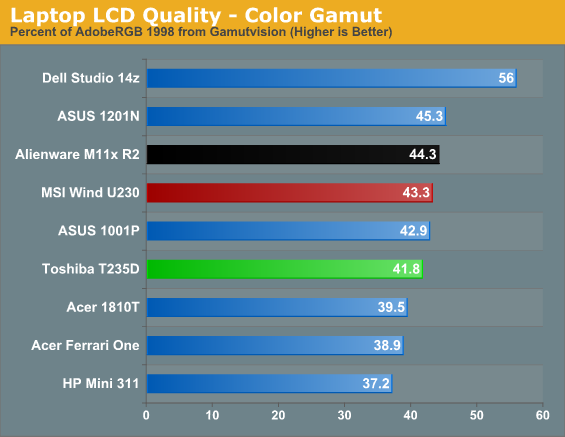
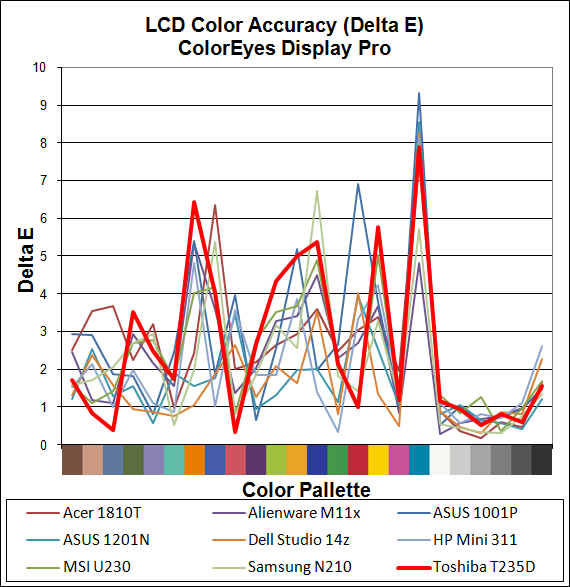
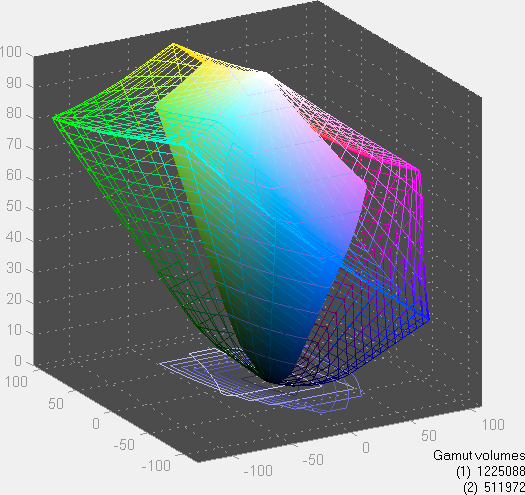
Color accuracy, quality, contrast, and viewing angles all fall in the typical category of "meh". The only area where the LCD rates above average is in maximum brightness, but that's accompanied by a very bright black point as well. Not surprisingly, when it comes to LCD quality you get what you pay for. No one is looking to put MacBook Pro type panels in entry level netbooks and laptops.
Temperatures and Noise
We received a request for details on the noise and temperatures for the T235D. Noise levels are very low; at idle the system drop below the 30dB noise floor of our test environment, and that's at a distance of just 12". We looped 3DMark06 at native resolution for 60 minutes to get a worst-case result for temperatures and noise as well. The maximum noise output reached 35.2dB at 12", which is still very quiet--though it would be audible in a quiet setting like a library. As for temperatures, we created the following table showing the temperature zones on the top and bottom.
| Toshiba T235D Temperatures | ||
| Idle (Celsius) | Load (Celsius) | |
| Left Keyboard Hand | 30-33 | 32-37 |
| Right Keyboard Hand | 27-29 | 27-29 |
| Left Palm Rest | 30-33 | 30-36 |
| Touchpad | 29-33 | 31-36 |
| Right Palm Rest | 26-28 | 27-30 |
| Left Bottom | 30-42 | 28-47 |
| Middle Bottom | 32-35 | 30-46 |
| Right Bottom | 27-30 | 26-31 |
Temperatures are relatively close to room temperature in most cases (testing in a 22C environment), but the left half of the system is clearly warmer than the right half. That's understandable as the left half is home to the chipset and processor, as well as the WiFi card. Interesting to note is that right around the WiFi chip is one of the hot spots of 40-42C at idle. On the right, the only real component is the hard drive, which doesn't contribute a lot to the heat. At load, the temperature range stretches some. Certain areas are actually cooler thanks to the added airflow from the fan, while in general the system as a whole gets a few degrees warmer. Overall, temperatures are similar to what we've experienced on CULV laptops, and we don't have any issues with using the system on our lap.















34 Comments
View All Comments
mczak - Wednesday, August 25, 2010 - link
per-clock performance of HD3200 and HD4200 is pretty much the same. The difference here (aside possibly from clock - not sure what clock the hd3200 used in the other notebooks were running at) is the platform. Most notably the HT speed, which was limited to HT-800 for Congo platform instead of HT1600 (for the K625). This basically halves the memory bandwidth available to the GPU and as you can guess this has a pretty disastrous effect on performance. Other differences are possible as well (e.g. different sideport memory), I believe some congo designs also ran their (ddr2) memory at a very low clock which could further lower scores though unless it was single channel it shouldn't make much of a difference since the HT-800 limits available gpu memory bandwidth still more. Well it could be a combination of slow memory and slow HT but whatever the case it's a bandwidth problem not architectural differences which make the HD3200 and HD4200 perform differently (unless you had an app which would use DX10.1 features).Hyperion1400 - Tuesday, August 24, 2010 - link
"Of course, battery capacities are a bit tricky—I know I have some 2500mAh 1.2V AA Energizer rechargeable batteries that suck compared to some equivalently rated 2500mAh Eneloop rechargeables"IxV gets you rated output(max power output assuming 0 ohm resistance). The only way to know the capacity of a battery is to rely on the manufacturer's word or to test the battery yourself.
Computer Bottleneck - Tuesday, August 24, 2010 - link
I think it is really interesting that older 45nm Intel's like SU7300 score better in battery tests than 32nm Arrandale i7-640um (found in Alienware M11 R2).Does this have anything to do with differences in peripherals (hard-drive, LCD, etc)? I noticed the Alienware has a 7200 rpm drive whereas the Acer Timeline 1810 has a 520 rpm drive. Or is the battery life difference related more to other factors? (I was expecting 32nm to definitely pull away from 45nm all things being equal).
JarredWalton - Tuesday, August 24, 2010 - link
I don't think most of the components make much of a difference. M11x isn't the most power-friendly implementation of Arrandale ULV, though, so we'll see how the ASUS UL80Jt stacks up next week. In general, though, the IGP in Arrandale is far more potent than the old GMA 4500MHD, and perhaps that's part of the difference.Intel specs the Arrandale ULV chips at 18W, which includes graphics. The CULV stuff was 10W, but I don't have a clear number on the chipset+IGP. It would appear that the chipset tops out at around 3W-5W for the IGP based on my testing here:
http://www.anandtech.com/show/2932/intel-core-2-cu...
Idle power draw on CULV may also be better, for whatever reason. Maybe 32nm has higher leakage, or it's just the number of transistors. I keep thinking the next 32nm parts from Intel will probably show much better power numbers, as this is really their first 32nm part. We'll see later this year with Sandy Bridge I guess.
strikeback03 - Tuesday, August 24, 2010 - link
All the testing with any Arrandale (ULV or not) has shown battery life not really improved from the later C2D processors, correct? Maybe there will be an improved stepping at some point.Computer Bottleneck - Wednesday, August 25, 2010 - link
Good point about Arrandale ULV possibly having higher leakage at idle. Maybe this is because i7-640um needs to be built on higher power wafers in order to hit the 2+ Ghz turbo speeds?Kishkumen - Tuesday, August 24, 2010 - link
As usual, the display just kills it all for me. A fine review, I just wish these laptop manufactures would throw us a freakin bone when it comes to some better displays. They're not doing themselves any favors with my pocket book anyway.Taft12 - Tuesday, August 24, 2010 - link
If you're referring to 1366x768, I fully agree!!Dell doesn't allow you to customize the screen nearly as much as they used to. Come on already, I am not paying over $600 for a laptop with that screen resolution!
The Crying Man - Tuesday, August 24, 2010 - link
Nice review. Is there any in the works with the N930 paired with an HD 5650? I have the dv6, but I'm just curious where it falls compared to all the other review laptops.JarredWalton - Tuesday, August 24, 2010 - link
I've got a P920 with 5650 review coming, but I do wish the CPU were faster. It's the Toshiba A665D... except the A665D is now discontinued and so my replacement system is the A660D. It's the same notebook but with a 7200RPM HDD AFAICT. Should have that up in the next week or so.